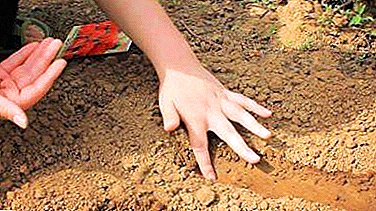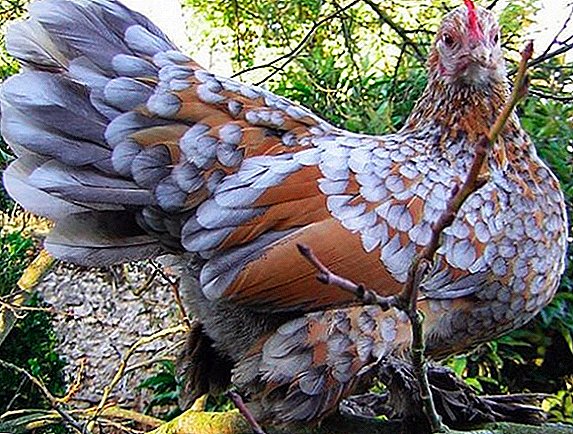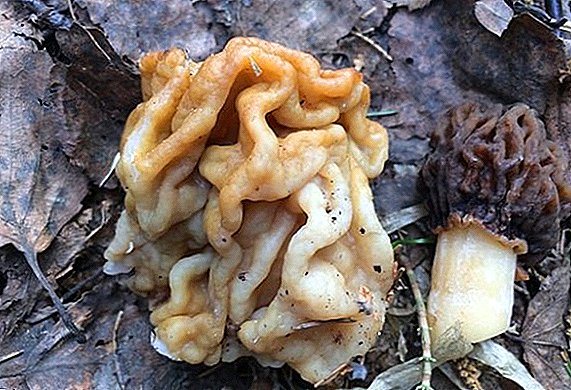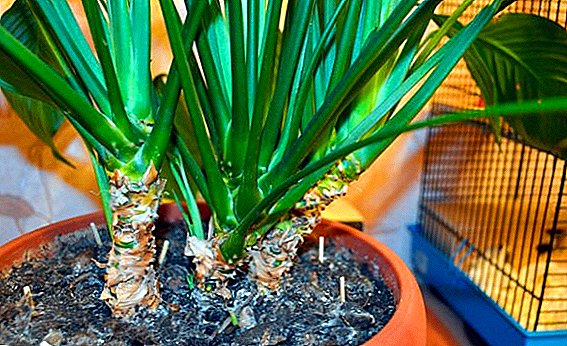 Among indoor plants, spatifillum occupy a special place. They are quite unpretentious in the care and very spectacular in appearance (especially during the flowering time). But the owners of such a miracle often take the question - how is the proper transplant of a tropical flower, and what is needed for this?
Among indoor plants, spatifillum occupy a special place. They are quite unpretentious in the care and very spectacular in appearance (especially during the flowering time). But the owners of such a miracle often take the question - how is the proper transplant of a tropical flower, and what is needed for this?
Do I need to replant spathiphyllum after purchase
Transplanting this plant after purchase is a prerequisite for keeping spathiphyllum. But you should not hurry with it: experienced growers recommend carrying out this procedure only 2-3 weeks after the acquisition. It will take so much time for the flower to get used to the new house (and the microclimate in the dwelling) at least a little. An earlier move will result in additional stress for him.  But there are exceptions to this rule. If it is noticeable that the flower massively shoots and buds right in the store, it means that you already have an “old” plant that you need to save (including by transplanting). However, such work poses a considerable risk for spathiphyllum - it is possible that the emergency transfer will become a strong depressing factor.
But there are exceptions to this rule. If it is noticeable that the flower massively shoots and buds right in the store, it means that you already have an “old” plant that you need to save (including by transplanting). However, such work poses a considerable risk for spathiphyllum - it is possible that the emergency transfer will become a strong depressing factor.
Is it possible to repot spathiphyllum during flowering
In the period of flowering transplant is very undesirable, but still possible. They take such a step in case of extreme necessity - when attacking earthen and leafy parasites or a clear loss of useful qualities of the soil.
Important! Adult plants closely in technical pots in which they are sold. Long stay in such a container inhibits the growth of rhizomes, which adversely affects flowering.The way out is the method of transfer: the plant is transferred to another pot without removing the soil coma from the roots. This method allows you to maintain a minimum balance of nutrients, so necessary during the flowering season. But again - a similar procedure is carried out only in an emergency situation. If you touch a blooming Spathiphyllum for no apparent reason, the plant may react by blackening or twisting the leaves. Often, the reaction to moving a healthy flower is the absence of ovaries.
Also transplant strawberries, grapes, chrysanthemum, peony, raspberry, orchid, violet, iris, lily, money tree and tulips.
How often do I need to transplant
Spathiphyllum is usually transplanted once a year in spring. Often referred to as another frequency - at intervals of 2 or even 3 years. However, for a flower with fast-growing roots forming a large ball in the ground, this is too long. "Overexposed" it in a close pot, the owner thereby reduces the intensity of flowering. Young specimens should be relocated once a year, and older ones every 2 years. 
When best to do it
The optimal time is the beginning of spring, even before flowering. But here, too, options are possible. For example, if later, when examining the green mass, it was found that the lower leaves began to shrink, then we will have to make a sanitary transplant.
Did you know? In Australia, unique flowers grow - Risentella orchids that bloom ... under the ground.The same applies to other difficulties like the invasion of parasites or problems with the pot itself. Important at this point is the air temperature in the room. It should be within + 20 ... +24.
Learn how to choose an orchid pot.
Spathiphyllum pot: selection and preparation
New capacity for a flower is selected, being guided by a simple rule, - the pot has to be a little more previous. The fact is that a developed root system, tightly gripping the soil, actively forms an earthen room. If, however, move the spathiphyllum to a volume that is too voluminous, flowering can take a long time (until the roots are located in the whole volume). With a gradual increase in the size of such difficulties does not arise, and the flower develops without extra effort. For this pick up the container with a diameter of 10-15 cm.  Choosing a new pot and making sure that it has a drainage hole, drainage is placed on the bottom. To do this, large pebbles, expanded clay or brick dust, laid in a layer of 1.5-2 cm, will be suitable. Practice shows that many gardeners, using clay pots, do not use drainage. A strong plant is not afraid, but in the case of a young and still fragile specimen it is still better to err.
Choosing a new pot and making sure that it has a drainage hole, drainage is placed on the bottom. To do this, large pebbles, expanded clay or brick dust, laid in a layer of 1.5-2 cm, will be suitable. Practice shows that many gardeners, using clay pots, do not use drainage. A strong plant is not afraid, but in the case of a young and still fragile specimen it is still better to err.
What soil is needed
Spathiphyllum will need a loose and light soil with weak acidity. The easiest way is to purchase commercial soil mixture for flowering tropical and aroid species, adding a little coarse sand to it.
Important! When buying a ready-made substrate, pay attention to the acidity - it should be less than 6.5 pH.Many prepare their own soil, and the most popular mixture of the following components:
- peat;
- leaf and turf ground;
- sand;
- sphagnum.
 It contains:
It contains:- 2 pieces of sod land;
- 1 part of sheet soil, peat and coarse sand;
- charcoal;
- brick chips;
- coarsely chopped tree bark;
- superphosphate.
Grow freesia, fir, dill, rose, coriander, juniper, cloves and eustoma in a pot.
Tools for work
The tool will need a minimum:
- garden shovel or shovel;
- sharp knife or scissors;
- spray.
Did you know? The first flower clock was planted nearly 300 years ago (in 1720). The pioneers in this direction were Swiss gardeners.You will have to work in gloves (preferably rubber - wearing cotton, you can lose weight with effort and damage the rhizome).

Preparing Spathiphyllum for Transplant
The initial stage of transplantation is the preparation of the flower itself. In the case of spathiphyllum, it is carried out according to the following algorithm:
- The soil in the old pot is moistened abundantly, and then gently hooked with a garden spatula.
- The plant is removed along with a lump.
- Then the rhizome is carefully cleaned from the old drainage and soil.
- Faded or too young sheets are cut off (in one step, do not torment the flower).
- Look for old leaves, and especially for their bases - they are also removed (to prevent rotting). Usually they break off without much effort.
- It remains to cut too long or rotten roots - and Spathiphyllum is ready to move to a new container.
Important! The cut sites are powdered with charcoal - it is a kind of antiseptic.
 Keep in mind that if the transplant is not performed for 2-3 years, then there will be a lot of such outlets, so if there is no space for new pots, it is better to refuse division.
Keep in mind that if the transplant is not performed for 2-3 years, then there will be a lot of such outlets, so if there is no space for new pots, it is better to refuse division.How to transplant to another pot
There are also no tricks here:
- Prepared wet substrate is poured on top of the drainage tank.
- In the middle of the pot make a small depression.
- It placed the leg with gently divorced roots.
- The hole is immediately filled up with a new portion of soil, not forgetting to crush the soil near the trunk (until its level reaches the leaves).
- Immediately after transplantation should be abundant watering. Prepare to ensure that the soil is slightly deposited, and the substrate will have to pour. This is an important point - if you miss it, the plant can stagger in a pot.
- Finally, be sure to spray the leaves.
Video: Spathiphyllum Transplant
Care after transplant
The first week after the transfer, the plant is kept in the shade, after which the pot is placed in its usual location (with a temperature of + 16 ... +27 and moderate indirect lighting). All this time, the leaves are sprayed daily, and if there are concerns about their withering, then several times a day.
Did you know? The roots of South African ficus grow to 120 m in length.The soil in the upper layer should be moderately wet - in the warm season the frequency of irrigation with warm soft water is 2-3 times (whereas in early spring 1-2 will be enough). Due to its tropical origin, spathiphyllum needs to maintain high (more than 50%) humidity. In rooms with heating on, it is not always possible to maintain such parameters. But there is a way out - for the first 1-2 weeks after the transfer, the flower is completely wrapped with transparent polyethylene, monitoring the water balance.
 About dressings there is a taboo: for 1.5 months from the date of transplantation they are not paid. After this period, they switch to the standard scheme; fertilizers are applied as usual (1 time per week during the growing season and 1 time per month during the cold season). Liquid dressings, organic materials or purchased mineral compounds without lime are used. Anyone can handle the task of transplanting spathiphyllum: accuracy and careful (albeit simple) care will be needed. Let the tropical plant pleases the eye and creates comfort in the home for many years!
About dressings there is a taboo: for 1.5 months from the date of transplantation they are not paid. After this period, they switch to the standard scheme; fertilizers are applied as usual (1 time per week during the growing season and 1 time per month during the cold season). Liquid dressings, organic materials or purchased mineral compounds without lime are used. Anyone can handle the task of transplanting spathiphyllum: accuracy and careful (albeit simple) care will be needed. Let the tropical plant pleases the eye and creates comfort in the home for many years!Reviews














